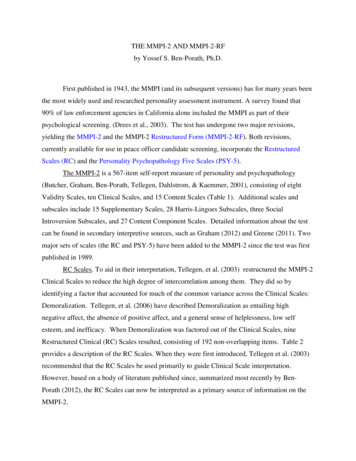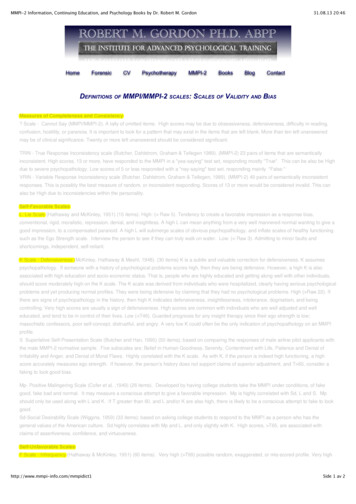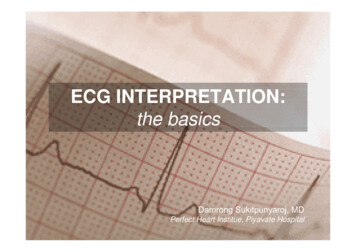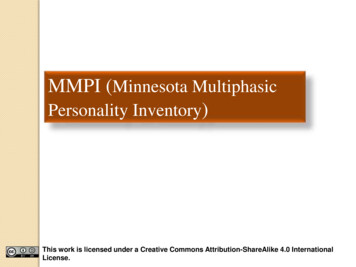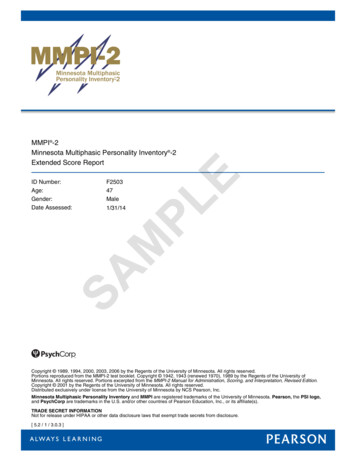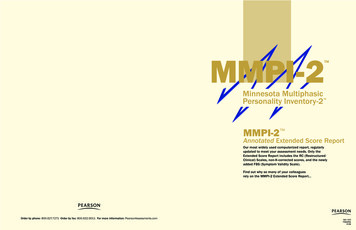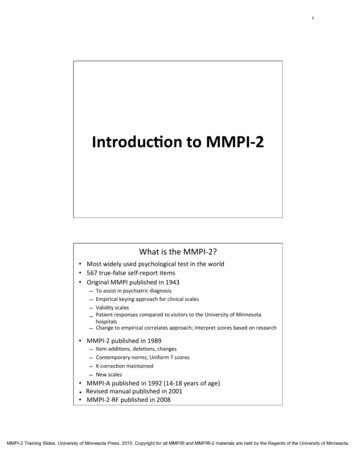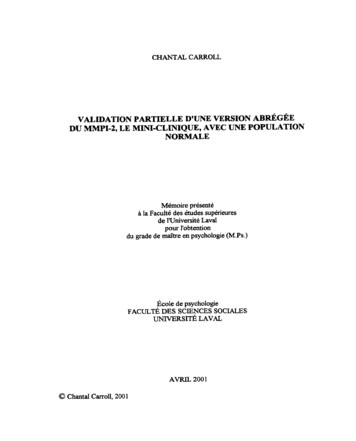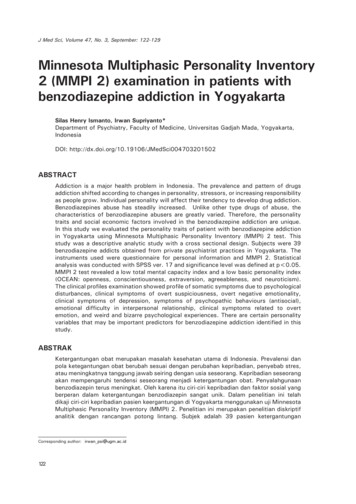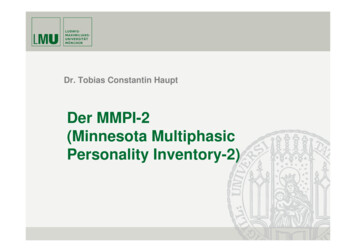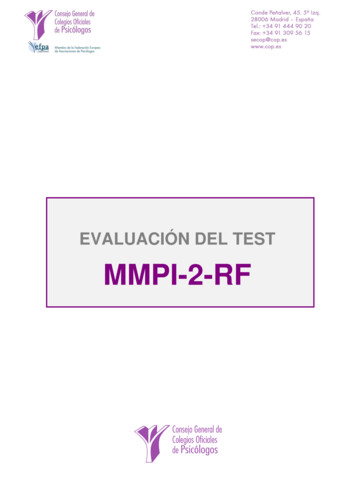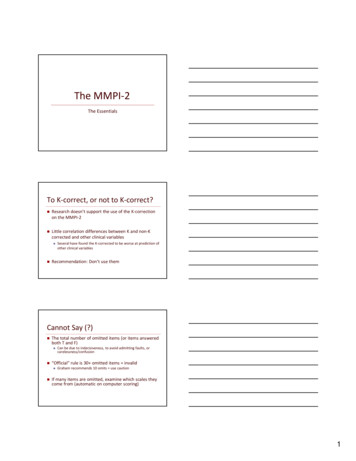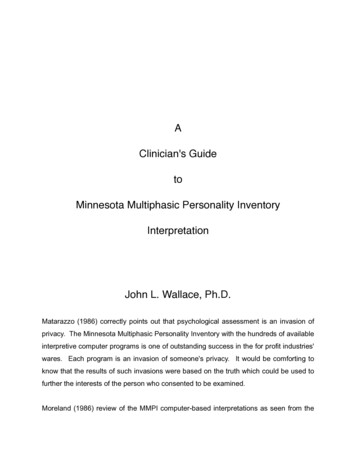
Transcription
AClinician's GuidetoMinnesota Multiphasic Personality InventoryInterpretationJohn L. Wallace, Ph.D.Matarazzo (1986) correctly points out that psychological assessment is an invasion ofprivacy. The Minnesota Multiphasic Personality Inventory with the hundreds of availableinterpretive computer programs is one of outstanding success in the for profit industries'wares. Each program is an invasion of someone's privacy. It would be comforting toknow that the results of such invasions were based on the truth which could be used tofurther the interests of the person who consented to be examined.Moreland (1986) review of the MMPI computer-based interpretations as seen from the
perspective of the results of external criterion studies, reveals a nine percent agreementbetween the statements and the people they describe. This writer has seen computerbased MMPI interpretations that were less accurate.The descriptor handbook has these advantages to the user:1)The descriptors are tied directly to a coded test feature;2)The entire catalog of codes and descriptors are available to the user;3)The statements are meant to be changed to suit the situation by the userand used in report writing by a responsible person.It is obvious that all psychological testing is invalid. The user of these descriptors is theonly one who can make them valid.If the test codes and the related descriptorsdescribe the client truthfully in the estimate of the user, then they may be useful infurthering the client's legitimate interests.These MMPI descriptors may be useful to the user. No other claim is made for them.Matarazzo, J.D. (1986). Computerized clinical psychological test interpretations.American Psychologist, 41(1), pp. 14-24.Moreland, E.L. (1986). Computer-based MMPI interpretations: Externalcriterion studies. Critical Items, A Newsletter for the MMPI Community, 2(2). NationalComputer Systems, pp. 2-3.The MMPI and MMPI-2 yield different scale elevations. This is related to (1) artificialinflation of the Tscores when the MMPI standardization groups' scores were notcontrolled for eliminated test items and (2) the MMPI Tscores ". . . were not uniform withrespect to the percentile rank across the clinical scales" (Pope et al., 1993).The result of the above is a lower mean Tscore for the validity and clinical scales for the
MMPI-2 and different two and three point clinical scale elevations (Lewak et al., 1990).The clinical interpretations in this text are based upon interpretations generated from theoriginal MMPI scale elevations.The exception is with those scales developedspecifically out of the MMPI-2 item pool. The reader is advised to plot the validity andclinical profiles when using the MMPI-2 using the tables in the MMPI-2 manual foradministration and scoring, pp. 152-155 (Hathaway and McKinley, 1989). The SkinnerModal Profile correlations must be calculated using the MMPI norms.Pope, K.S., Butcher, J.N., and Seelen, J.(1993).The MMPI, MMPI-2, andMMPI-A in court: A practical guide for expert witnesses and attorneys. Washington,D.C.: American Psychological Association, pp. 17-18.Lewak, R.W., Marks, P.A., and Nelson, G.E.MMPI and MMPI-2:(1990).Providing feedback and treatment.Therapist guide to theBristal, PA:AcceleratedDevelopment, p. 11.Hathaway, S.R. and McKinley, J.C.(1989).Manual for administration andscoring MMPI-2. Minneapolis, MN: University of Minnesota Press, pp. 151-55.
Minnesota Multiphasic Personality InventoryInstructions for IndividualsThis inventory consists of numbered statements. Read each statement and decidewhether it is true as applied to you or false as applied to you.Please read number one aloud. [Have the client read statement number one aloud.Now ask the client to tell you, "Is the statement more true of you or more false of you?"Mark the answer on the answer sheet so the client sees how they are to mark eachstatement. Ask the client to read statements two and three aloud. This usually givesthe client sufficient information on what is being demanded of them. It also yieldsenough information for the examiner to decide whether the client can manage thedemands successfully.]Remember to give your own opinion of yourself. It is best to answer honestly and trynot to appear too perfect or too good or too bad. The test has built in scales that woulddetect (1) if you are trying to look like you don't have problems, (2) that you are trying tolook like you have problems you don't really have, or (3) you are exaggerating theproblems you do have.Each statement is numbered. Each answer is numbered. Mark the answer that has thesame number as the statement. The first column is white. The next page has a bluecolumn. This helps you keep track of where you are. Please mark your answers withthis pencil. Make really black marks. Mark only true or false, not both true and false.Erase your answer cleanly if you change your mind. Please do not write on the booklet.Try to answer all of the statements. Tell me when you are finished if you didn't answerall of the statements.
Statistics for:WordPerfect DocumentInstructions for IndividualsReadability StatisticsFlesch Reading Ease:Gunning's Fog Index:808Flesch-Kincaid Grade Level: 5Paragraph StatisticsNumber of paragraphs:6Average length:Sentence StatisticsNumber of sentences:Average length:2511.6 wordsShort ( 12 words): 20Long ( 30 words): 1Word StatisticsNumber of words:299Average length:4.31 lettersSyllables per word: 1.364.1 sentences
Minnesota Multiphasic Personality InventoryInstructions for GroupsThis inventory consists of numbered statements. Read each statement and decidewhether it is true as applied to you or false as applied to you.You are to mark your answers on the answer sheet attached to the inside back cover ofthis booklet. Look at the example of the answer sheet shown in the instructions at theright in the box. If the statement is true or mostly true, as applied to you, blacken thecircle with the "T." (See "A" at the right.) If a statement is false or not usually true, asapplied to you, blacken the circle with the "F." (See "B" at the right.) If a statement doesnot apply to you or it is something that you don't know about, make no mark on theanswer sheet. Try to give a response to every statement.Remember to give your own opinion of yourself. It is best to answer honestly and trynot to appear too perfect or too good or too bad. The test has built-in scales that woulddetect (1) if you are trying to look like you don't have problems, (2) that you are trying tolook like you have problems you don't really have or, (3) are exaggerating the problemsyou do have.Each statement is numbered. Be sure the number next to the statement corresponds tothe number on the answer sheet. Please mark your answers with a pencil, not aballpoint. Blacken only one response for each statement. Erase completely anyanswer you wish to change. Do not make marks on this booklet.Remember, try to respond to every statement.Now start with statement 1.
Instructions for GroupsReadability StatisticsFlesch Reading Ease:Gunning's Fog Index:7610Flesch-Kincaid Grade Level: 6Paragraph StatisticsNumber of paragraphs:9Average length: 2.1 sentencesSentence StatisticsNumber of sentences:Average length:1914.4 wordsShort ( 12 words): 15Long ( 30 words): 2Word StatisticsNumber of words:281Average length:4.20 lettersSyllables per word: 1.37
MMPI-2 Report OutlineNameNumberDateRequested by:YMDReason:YMDOBDAgeYMThe Minnesota Multiphasic Personality Inventory - 2 (Second Edition 1989) wasadministered. The descriptors below are suppositions about this person's behaviorwhich are to be used as a basis for further investigation by which they may be proved ordisproved. The ultimate validator is the person who has taken responsibility for writingand signing the report. The information in this report is confidential and should be usedonly by qualified licensed professional persons.ValidityCannot say score (?)raw 29 in first 370 itemsInterpret with Caution 30 in first 370 itemsUninterpretable TestPossible causes are for the lack of data acceptability tor Slowness7.Can't Read(well)4.AntagonismL 9 rawL5.RigidityHe/She wishes to present Himself/Herself in an unusuallyfavorable manner that may not be warranted on the basis ofHis/Her customary behavior.rawNumber(Numbers 1045-1054)Ts
F (Infrequency)rawTsNumber(Numbers 1055-1060)F (p) Infrequency-Psychopathology ScaleF (p) Ts 69.He/She endorses a large number of infrequentlyreported items as compared to both nonpatient and patient groups. He/She may beattempting to appear more compromised thanHe/She really is.F (B) Backside F ScaleF (B)rawrawTs 89 and F Ts 90 InterpretableF (B) Ts 90 and F Ts 90K DefensivenessrawHe/She has answered the F (B) itemsrandomly. Supplemental Scales interpretationsshould be done cautiously if at all.TsNumber(Numbers 1055-1060)S Superlative ScaleSTs 69.rawHe/She is reporting an absence of adjustmentproblems, negative personality features andhigh self-control.F-K F Higher ; K Higher rawrawNumber(Numbers 1095-1100)
F-K raw raw(F Higher; K Higher)Number(Numbers 1095-1100)VRIN (Variable Response Inconsistency)VRINTs 75VRINTs 75 and FRawIndiscriminate responding is apossibility. 75The test items were responded to in arandom manner.Interpretation is problematic.VRINTs 65 and FVRINTs 75 and TRINTs 80TruePsychopathology is probablypresent.False Ts 75Indiscriminate falseresponding is present.TRIN (True Response Inconsistency)TRINT or F, Ts 74 T orTs 81 FValidity screening indicatesrawInconsistent responding ispresent.The test results areinterpretable.An interpretation may yieldunacceptable results.
Es (Ego Strength)EsrawTsNumber(Numbers 1000-1020)EsTs 39Es 39 and KHe/She relies heavily upon others.Ts 41He/She is not able to manage his/her affairs byhimself/herself.Clinical ScalesOne and Two point scale elevations.(Numbers e(s)TsTsNumberSkinner Mean Clinical Scales Elevations
MeanTs 62MeanTs 62 and 4A low lying mean profile elevation suggests theabsence of frank psychopathology. Ts 66He/She may be seen as self-centered, selfinvolved and self-serving.MeanTs 63-67He/She is depressed. Work is not gratifyingand relationships bring Him/Her little pleasureor comfort.MeanTs 68He/She cannot think clearly enough to solvepersonally important problems.Skinner Common TypesCode TypeHighest Common TypeSkinner Correlation ProcedureModal Profiler 0.NumberModal ProfileNumberr 0.
Modal ProfileNumberr 0.
Skinner Modal ProfilesCorrelation ProcedureLFKHs D HyPd MfPa Pt Sc Ma SiPatient'sT-ScoresCore DysfunctionAffective43 39 47 67 66 67 51 44 43 54 47 37 44 .BACognitive35 56 32 44 57 44 55 43 57 61 68 49 69 .BBPersonalityDisorder42 48 51 51 44 57 70 45 49 42 47 69 33 .BCAlcoholism47 63 49 63 71 64 73 62 61 67 65 61 55 .BDAnti-SocialPersonalityDisorder50 64 48 59 77 65 81 64 65 71 76 65 55 .BEBorderlinePersonalityDisorder46 82 44 70 87 67 81 69 73 83 84 68 66 .BFMixed Neuropsychological53 60 53 77 82 64 64 57 59 62 63 60 56 .BGDysthymia46 70 44 65 84 67 76 71 65 71 76 60 58 .BHGeneralizedAnxiety Disorder50 64 46 75 89 73 81 69 65 77 76 60 56 .BIHystericalNeurosis44 62 46 72 77 69 62 59 59 71 71 58 55 .BJClinicalGroupsResponse bias leadingto potentially lowered
ability and achievementscores and positiveneurobehavioraltest scores50 73 51 77 87 67 76 59 67 77 86 63 65 .BKPost-TraumaticStress DisorderBL51 66 49 75 81 73 72 55 66 72 75 62 61 .
Skinner Modal ProfilesCorrelation ProcedureMegargee TypesAble (domineering)56 58 55 49 56 55 69 57 53 52 55 73 71 .BMBaker (distressed)53 60 51 49 70 56 71 55 56 54 57 63 58 .BNCharlie (bitter)50 82 46 59 70 58 76 64 82 71 84 75 58 .BODelta (amoral)50 64 59 59 70 58 83 61 59 62 63 63 52 .BPEasy (underachiever)56 55 62 59 65 64 67 55 53 58 59 60 49 .BQFoxtrot (street wise) 50 84 51 54 63 56 76 57 59 60 74 81 51 .BRGeorge (submissive) 56 58 59 59 75 62 71 57 53 58 57 58 51 .BSHow (markedlydisturbed)56 78 53 80 89 76 81 64 76 81 88 65 61 .BTItem (well adjusted) 53 60 53 54 63 55 62 61 56 56 55 60 52 .BUJupiter (impulsive)53 66 49 52 63 51 64 59 59 73 80 78 55 .BVPsychotic50 88 35 59 79 62 67 55 88 62 78 63 63 .BWDisoriented60 102 42 75 84 87 67 67 94 71 88 63 69 .BXWithin normallimits66 58 62 47 65 56 43 53 53 48 55 43 47 .BYHostile56 66 44 34 65 53 53 53 65 30 44 50 53 .BZHolcombMurder Types12
Depressed70 73 53 56 72 67 60 55 76 38 50 50 60 .CA
Cognitive StatusNewmark ThoughtDisorder IndexA formal thought disorder may bepresent.8 Ts 80 - 100 8TsF Ts 75 - 95 FTs8 to 7 (Hard Rule) 8Ts/78 raw/K raw 35% Kraw8All 4 signs must be presentBIZA polysubstance abuse induced thoughtdisorder may be present.Ts 75 Ts%No thought disorder is suggestedby these data.He/She is reporting psychoticthoughts, experiences andhallucinations.Schizoidia IndexrawTsA 75 TsFunctional vs. Neuropsychological EtiologyHe/She gets little pleasure orcomfortfrom living (raw must be 5).He/She is extremely anxious and fearful.P-O (Psychotic-Organic) Indexraw.normalfunc.organHs-PtHsPt TsTsTshigh . funchigh . organRussell Key ClassHis/Her functioning may besignificantly influenced byfunctionalorganic factors.The Russell Key reflectsfunctionala functionalequivocalan equivocalneuropsychologicalHsHis/Her functioning may besignificantly influenced byfunctionalorganic factors. 75 Tsan organic patternHe/She lives with confusion anduncertainty concerning his/her health.
CRIPE NEUROLOGIC SYMPTOM CATEGORIESHe/She is trying to communicate the following symptoms to us:Attention/Mental Control (AM) 7TTT.TTTT31.122.299.325.341.475.525.BIOBEHAVIORAL (BB) 6FFFTFT12.20.143.166.208.253.EMOTIONAL/BEHAVIORAL CONTROL (EB) 13.
F564.FATIGUE/ENERGY (FE) 6FTFTTF152.175.330.366.464.561.GENERAL COGNITIVE (GC) 10TFFTT
MMPI-2 and different two and three point clinical scale elevations (Lewak et al., 1990). The clinical interpretations in this text are based upon interpretations generated from the original MMPI scale elevations. The exception is with those scales developed specifically out of the MMPI-2 item pool. The reader is advised to plot the validity and clinical profiles when using the MMPI-2 using .
